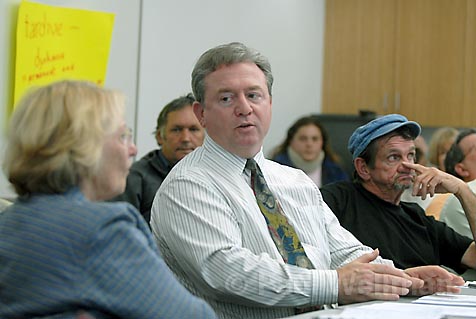Prescription for Budget Woes Worries Uninsured Patients
Changing Meds

With the Santa Barbara County Board of Supervisors headed toward another tight budget in the coming fiscal year and departments looking for ways to cut costs, local users and supporters of the county’s services for the uninsured mentally ill are nervous about a new system that will soon introduce older, cheaper medication-that is, those from pharmacological generations that have more side effects-onto lists of approved treatments for patients.

In a stuffy conference room tucked into the back of the newly remodeled Santa Barbara Children’s Building on the county’s Department of Alcohol, Drug and Mental Health Services (ADMHS) campus Tuesday, roughly 35 people loomed over the 11-member Mental Health Commission and shared their concerns during the course of a sometimes chaotic meeting. Many patients and advocates-including some from the groups Prop 63 for Me and MHS Our Way-are concerned about the county reverting to the use of older, side effect-prone psychiatric medications for the uninsured in an effort to save money. With better medicine available, there should be no reason to prescribe the older medication, they say. Some people are afraid of the side effects and have sworn off taking such meds. “It’s really doing harm,” said Norma Kutzer, a supporter of the medication consumers. Another advocate, Jamie Ader, agreed. “[The department] wants to give them help, but the truth is they’ll be giving them medication that is archaic,” she said.
ADMHS medical director Dr. Jeff Davis said despite efforts to save money, the organization would manage its resources to “give the most it can to the most people.” He said some non-brand names will be added to the list of available medications, noting that the older ones differ slightly in bioequivalence but are generally the same. It will be up to the doctor to know which would be most effective for the patient. With the new system, uninsured clients will be under a new formulary. In the managed-care system, the doctor will select from a pool of accepted drugs, making sure to be as “fair and balanced as can be,” said ADMHS interim director Douglas Barton.
Doctors have not explicitly been told to use the cheapest or oldest medication for uninsured patients, but will use what in their view is the best under the given circumstances. Doctors will be able to consult a list for the most cost-effective options. But there are other factors going into a doctor’s decision, Davis said. For instance, some doctors refuse to switch to prescribing first-generation medication for fear of lawsuits, preferring to stick with what they know. Davis said he understood these concerns, but even with side effects, the older medications may not necessarily be worse. “There are patients who do better on the older agents,” he said. “There is literature that suggests the same.”
Medi-Cal and Medicare have approved formularies, so doctors have a range of medications from which to choose. But some time ago, a pharmaceutical waiver was developed by ADMHS for individuals not covered by either of the two government programs and who lacked a way of paying for medication. More recently, fees have been waived even for individuals with health insurance if the medication thought needed by a doctor wasn’t on the approved list. Five years ago, the county waived roughly $350,000 worth of medication. Last year, the amount had risen to roughly $1.2 million. “Unfortunately, economics come into it,” Davis said.
With a department deficit of $5.2 million, ADMHS is looking to change more than just the kind of medication it dishes out; the costs of medication, management, and treatment programs will all be examined to see what can be cut. But customers are worried they will be the ones left out to dry.
Doctors aren’t consistent, said Ader. “Certain doctors care about [patients’] best interests, and there are doctors concerned about keeping them quiet, about keeping them from coming in too many times and making waves,” she said. Patient advocate Chuck Hughes argued that giving patients the wrong medicine would actually cost the county more money if a trip to the hospital is needed to rectify the situation. “He’s absolutely right,” Davis said. “We want what’s going to work for them.”
Regardless, the program is one people want to continue. In many places, people are on their own if they don’t have insurance, according to Chhitu Patel, a Mental Health Commission member and Santa Maria pharmacist. Patel listed coupons and samples from marketing and sales representatives as ways to save money. Through the application of these principles in Santa Maria, costs were reduced by two-thirds. Davis agreed. “There are vehicles to get the medication paid for,” he said.



